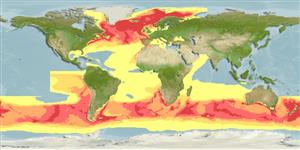Common names from other countries
Environment: milieu / climate zone / depth range / distribution range
Ecología
Pelágico; rango de profundidad 30 - 1800 m (Ref. 122880). Polar; 90°N - 90°S, 180°W - 180°E
Northeast Atlantic, Atlantic Ocean, Indo-Pacific, Mediterranean, and the Antarctic: Central Pacific sector at 68°S, 120°W; Globicephala melas melas: Ungava Bay, Greenland, Iceland, Faroes, Norway, North Carolina, Azores, Madeira, Mauritania, Western Mediterranean, Newfoundland; Globicephala melas subsp.: Japan, Sea of Japan; Globicephala melas edwardii: Brazil, South Africa, Crozet, Heard Island, Australia, New Zealand, Chile, Scott Island, Antarctic Convergence (Ref. 1522). Polar, subtropical.
Length at first maturity / Tamaño / Peso / Age
Maturity: Lm ? range ? - ? cm Max length : 670 cm TL macho / no sexado; (Ref. 1394); 570 cm TL (female); peso máximo publicado: 2.0 t (Ref. 1394)
Found in oceanic waters and some coastal waters of the North Atlantic Ocean. Feeds on squid and sometimes small medium-sized fish (Ref. 1394). Found in oceanic waters and some coastal waters of the North Atlantic Ocean. Feeds on squid and sometimes small medium-sized fish (Ref. 1394).
Jefferson, T.A., S. Leatherwood and M.A. Webber. 1993. (Ref. 1394)
IUCN Red List Status (Ref. 130435)
CITES status (Ref. 108899)
Human uses
Pesquerías: comercial
FAO - pesquerías: landings, species profile | FishSource | Sea Around Us
Herramientas
Fuentes de Internet
Estimates based on models
Preferred temperature
(Ref.
115969): 1.6 - 10, mean 3.7 (based on 3239 cells).
Resiliencia
Bajo, población duplicada en un tiempo mínimo de 4.5-14 años (K=0.1; tm=12).
Vulnerability
Very high vulnerability (90 of 100).
Price category
Unknown.
